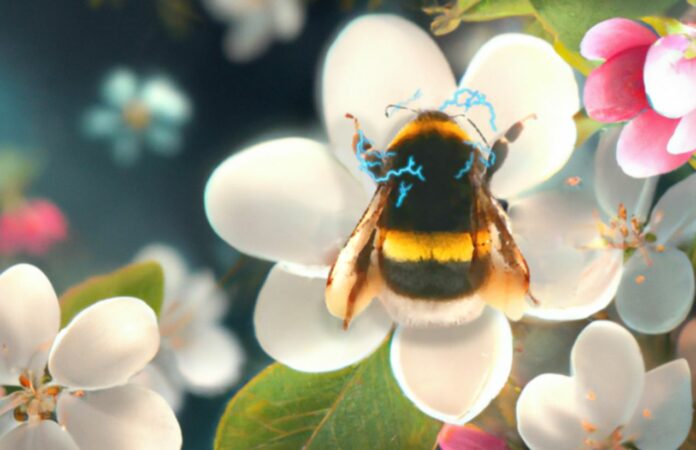According to a new research published in PNAS Nexus by Oxford University Press, agricultural chemicals such as fertilizers and pesticides can modify the way bees ‘see’ a flower, reducing the number of bees visiting the flower.
Flowers emit a variety of cues and attractants to insects, promoting feeding and pollination. Bees find their way around by using color, the sun, and magnetic fields. They recognize plants on a smaller scale by using cues like flower color and fragrance, as well as humidity and electric fields.
Routinely, farmers use large-scale spray treatments to apply chemical combinations, specifically fertilizers, to plants. The widespread use of chemicals in farming and gardening is a major source of pollution and has been linked to a drop in the size and variety of bee populations.
Although many of these compounds have long been known to be harmful, little is known about how agrochemicals disrupt the direct relationship between plants and pollinators. Sprays can change the way flowers look and smell in many ways.
Many chemicals used in farming have an electric charge that helps them stick to plants. So, spraying a flower could possibly change the electric fields around it.
“Flowers have a range of cues that attract bees to promote feeding and pollination. For instance, bees use cues like flower odour and colour, but they also use electric fields to identify plants,” said Dr. Ellard Hunting of Bristol’s School of Biological Sciences.
“A big issue is thus – agrochemical application can distort floral cues and modify behaviour in pollinators like bees.”
Here, scientists looked at what happened when they sprayed fertilizer on different flowers that bees use to find food. They noticed that while the chemical had no effect on their senses of sight or smell, it did cause a change in the electric field around the flower. To show this, the scientists sprayed cut flowers with an aerosol of positively charged, colored particles.
To gain a better understanding of what altered in the flower, researchers evaluated the bioelectric potential of the flower’s stem. This potential is a significant contributor to the electric field that surrounds flowers.
They found that spraying chemicals caused a change in this bio-electric potential that lasted for up to quarter of an hour. This change is a lot longer than natural changes like those caused by the wind, and it fits with natural drops in bees’ efforts to feed (about 20 minutes) that have been seen.
It’s interesting to note that scientists found the plant responded the same way after using chemicals and a simulated rain event, showing the effect lasts longer than the duration of the chemical use.
To find out if bees can really tell when a plant’s electrical signature changes, researchers used electricity to make flowers act like the electrical changes caused by fertilizers in the field.
They noticed that when bumblebees were flying toward the flowers, they were less eager to settle on an electrically modified flower than they were on an unmodified control flower. This demonstrated that bumblebees are able to recognize and distinguish between the small, dynamic electric field changes brought on by agricultural chemicals.
The fact that fertilizers change the way pollinators behave by changing how an organism perceives its physical environment shows “a new perspective on how human-made chemicals disturb the natural environment,” according to Dr. Ellard Hunting.
It also shows how important it is to think about the senses that insects use to understand and learn about their surroundings, even though they seem to be hidden.
“The fact that fertilisers affect pollinator behavior by interfering with the way an organism perceives its physical environment offers a new perspective on how human-made chemicals disturb the natural environment,” the author added.
“Imagine yourself not being able to distinguish apples from tomatoes because someone sprayed some chemicals in the vegetable department. This may be relevant for all organisms that use the electric fields that are virtually everywhere in the environment.’’
“This widens our understanding of the multifaceted ways in which human activity is negatively impacting the natural world,” added co-author Sam England, “which can seem quite depressing, but it will hopefully allow is to introduce or invent solutions to prevent the adverse effects that these chemicals may be having on bees.”
Image Credit: Benjamin and Joseph Tiso
